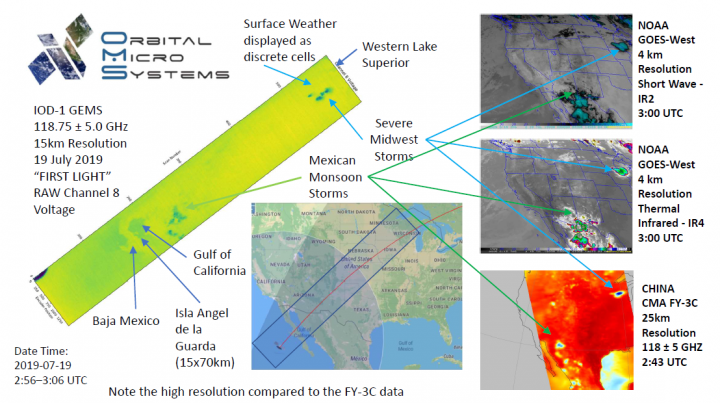Orbital Micro Systems Achieves Earth Observation Breakthrough
First commercial weather imaging satellite—designed and deployed in record time—sets the stage for weather data advances impacting global business and government interests

About Orbital Micro Systems
Orbital Micro Systems, a Bayes Partner, specializes in the development and delivery of technology and data for space applications. With broad expertise in applied science, weather science and earth observation, instrumentation development, data science, space operations, and program delivery, OMS is positioned to deliver innovation to many areas of the aerospace sector.
For more information about OMS, please visit www.orbitalmicro.com.
Edinburgh UK, August 19, 2019 – Orbital Micro Systems (OMS), a leader in advanced instrumentation for small satellite missions and analysis-ready earth data intelligence platforms, announced that data received from its IOD-1 GEMS satellite, deployed from the International Space Station on July 3, 2019, has proven the commercial viability of the company’s advanced earth observation platform. OMS’s miniaturized passive microwave radiometer onboard the satellite outmatched the best available microwave and infrared views of weather structures on earth, showing excellent clarity and detail not previously possible.
This is the first commercially funded passive microwave radiometer in space, and we packed in innovation at every turn, including the first use of a 3D-printed antenna and feedhorn in space, to dramatically reduce size and weight while creating a durable and reliable platform to gather weather information on a scale only imagined until now
Having proven the software and hardware are doing exactly what we wanted, we are moving forward with our plans to deliver actionable weather information to many global markets through the International Center for Earth Data (ICED), which will process and deliver analysis ready data to subscribers within minutes of observation.
OMS has positioned itself to serve numerous markets in desperate need for frequent, reliable and cost-efficient earth observation data that will have a profound impact in agriculture, energy, transportation, insurance, and other sectors that impact society at all levels.
There are many global regions where weather observations are taken at intervals from tens of hours to days
When the GEMS constellation reaches just ten satellites, we will reduce this interval to approximately one hour for any point on earth. This will fuel safety, security and prosperity initiatives in underserved markets. And, through our ICED marketplace, OMS is helping streamline the consumption of weather data through eliminating much of the pre-processing of raw data needed before actionable information can be derived
The GEMS program will ultimately incorporate some 48 CubeSats equipped with observation instruments operating in low earth orbit to gather low-latency atmospheric weather data at eight altitudes. When fully complemented, the global revisit rate will be near 15 minutes.
When combined with spatial resolution of 12 km compared with the 25 km spot provided by the FY-3C satellite, the more frequent observations will enable true nowcasting of weather events with levels of detail such as the ability to discern hail from rain, precipitation density within hurricanes and other storms, and improve the ability to plan for and react to critical weather events.
OMS’ approach to gathering Earth observation data, combined with the company’s business model to collect and deliver expanded data to commercial market customers, should be very impactful to the multiple sectors operationally and financially affected by weather
The early data results are certainly impressive, and we look forward to seeing OMS move the needle on how the commercial space industry gathers, processes, and delivers actionable intelligence following their lead
Organizations contributing scientific support, advice, and collaboration to OMS include the University of Colorado at Boulder, the University of Edinburgh, the National Snow and Ice Data Center, and the Center for Environmental Technology. In addition, Innovate UK and Space Applications Catapult provided funding and support for the launch and ground support of the IOD-1 GEMS mission.
For more information about Orbital Micro Systems please visit www.orbitalmicro.com

